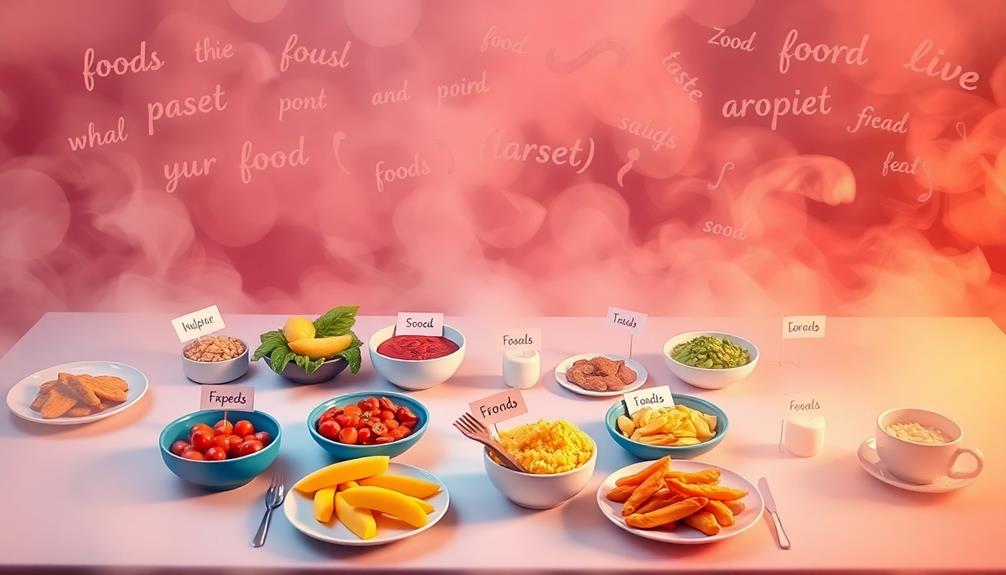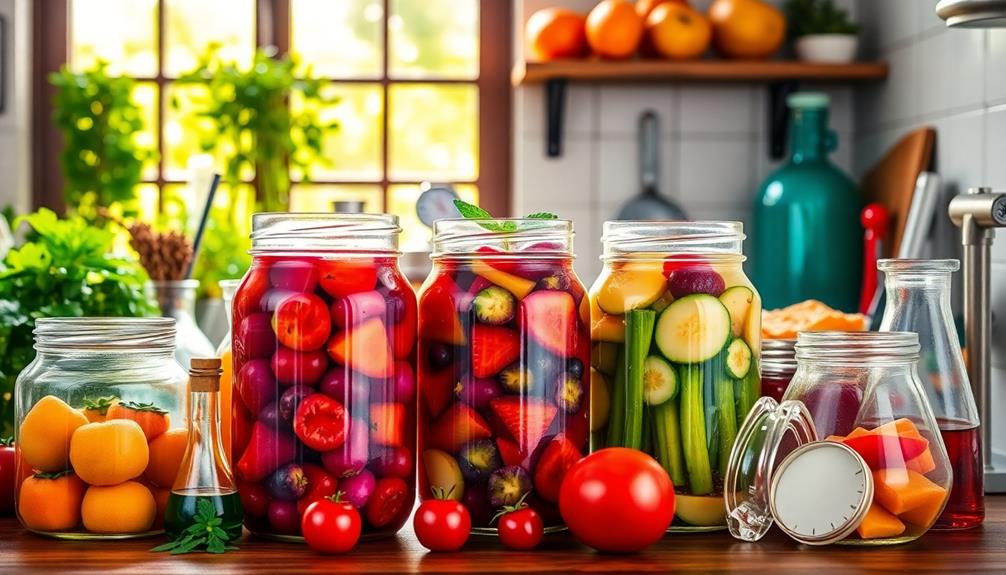Language influences your taste perception in surprising ways. Descriptive words like "crispy" or "zesty" elevate your sensory experience, making flavors more memorable. Cultural terms add depth, reflecting the unique tastes and values of different cuisines. However, translating these culinary expressions can be tricky, as meanings often shift across languages. Remember that aromas, textures, and even temperature play a significant role too, combining with language for a richer tasting experience. By exploring these connections further, you'll discover even more fascinating insights about how language shapes what you enjoy on your plate.
Key Takeaways
- Descriptive language enhances taste perception by creating vivid mental imagery, influencing how flavors are experienced and rated.
- Cultural culinary vocabularies reflect unique taste values, shaping perceptions of freshness, texture, and flavor balance in different cuisines.
- The translation of culinary terms can be challenging, as cultural connotations and subjective taste interpretations vary significantly across languages.
- Non-gustatory factors, such as aroma and visual presentation, are influenced by language, affecting expectations and overall flavor enjoyment.
- Technology facilitates cross-cultural exchanges of culinary terms, reshaping communication and enhancing the accessibility of culinary language.
Descriptive Language and Taste
Descriptive language acts as a powerful tool in shaping your taste perception. When you read words like "crispy," "tender," and "zesty," they create vivid mental images that enhance your sensory experiences even before the food reaches your palate.
For instance, a dish described as having a "creamy avocado spread" can evoke a rich texture that makes you enthusiastic to try it. Studies show that rich, sensory-laden language can lead to higher taste ratings and greater satisfaction. You might find yourself more thrilled about a dish after reading a mouthwatering description, as it boosts your appetite and interest in the meal.
Specific adjectives can evoke emotional responses, making your culinary experience more memorable. For instance, describing a dessert as "decadently rich" or "lightly whipped" can influence how you anticipate its taste and texture.
Additionally, the use of metaphors and similes can elevate your dining experience, demonstrating just how impactful language can be in culinary marketing. A perfect example of this is the way a "layered dip" can be transformed into a festive centerpiece like Graveyard Taco Dip, making the experience visually appealing as well.
It's also essential to recognize cultural differences in culinary vocabularies. These nuances can greatly affect how you perceive tastes and textures, reminding you that context matters.
Ultimately, the right descriptive language can transform a simple meal into an extraordinary experience that lingers in your memory.
Challenges in Food Translation
When it comes to sharing culinary experiences across languages, challenges arise that go beyond simple word-for-word translations. Translating food descriptions requires you to capture not only the literal meanings but also the sensory appeal and cultural nuances that shape taste perception.
| Challenge | Example |
|---|---|
| Cultural Connotations | "Crispy" means different things in various cultures. |
| Unique Culinary Vocabularies | Extensive texture terms in Chinese cuisine. |
| Subjective Nature of Taste | Individual preferences lead to varied interpretations. |
Words like "umami" often lack direct equivalents, making it tough to convey the same taste experience. The subjective nature of taste complicates matters even further, as your preferences and cultural values can shape how you interpret food descriptions. As you navigate these challenges, remember that effective translation is about more than just language; it's about connecting through shared culinary experiences. Understanding these nuances can enrich your appreciation of global cuisines and enhance your dining experiences.
Cultural Culinary Vocabulary
Cultural culinary vocabulary plays an essential role in how people understand and appreciate food. Each culture boasts unique culinary vocabularies that reflect its specific taste values, influencing how you perceive and describe textures and flavors.
For instance, in Chinese cuisine, words like huā (slippery) and xiān (fresh) emphasize the importance of texture and freshness, highlighting the significance of culinary integrity. Similarly, dishes like Dorayaki (Red Bean Pancake), which combine flavors and textures in a delightful manner, enrich the understanding of Japanese culinary terms.
Similarly, Vietnamese dishes like phở aren't just meals; they symbolize cultural identity and history, demonstrating how food terminology transcends mere translation.
In Thai cuisine, the complex balance of flavors requires nuanced language for accurate representation, showcasing the necessity of culturally appropriate descriptions.
When you engage with cultural culinary vocabulary, you foster connections to identity and heritage, shaping how you appreciate and communicate about diverse cuisines. Understanding these terms not only enhances your culinary experience but also deepens your appreciation of the cultures they represent.
This connection between language and taste perception reveals the intricate relationship between what you eat and how you discuss it, enriching your overall experience with food from around the world.
Case Studies in Taste Perception
Understanding how language influences taste perception becomes even clearer through specific case studies. These examples show how the language spoken directly impacts culinary practices and the appreciation of sensory attributes, such as the rich flavors found in Mushroom Masala and their descriptions.
- Umami in Japanese Cuisine: The concept of umami, identified in 1908, highlights a unique taste profile that shapes flavor pairings and culinary practices in Japan.
- Xiān in Chinese Cuisine: The term xiān (fresh) underscores food integrity, demonstrating how cultural concepts influence perceptions of taste and quality.
- Mouthfeel Vocabulary: Chinese cuisine boasts an extensive vocabulary for textures, reflecting the significance of mouthfeel and how language can enhance the appreciation of food's sensory attributes.
- Cultural Identity in Vietnamese Dishes: Dishes like phở symbolize cultural identity and history, illustrating the intertwining of language and taste perception.
These case studies highlight that your experience of food is profoundly influenced by the words and concepts embedded in your culture.
Whether it's the appreciation for umami or the importance of freshness, the language you use plays a significant role in shaping your taste perception.
Technology's Role in Culinary Language
As technology evolves, it reshapes the way we communicate about food, making culinary language more accessible and engaging. You can see this transformation in how restaurants use data analytics to tailor their marketing strategies based on consumer preferences. By analyzing culinary discourse, they can refine menu descriptions that resonate more deeply with their audience, enhancing your dining experience.
The influence of diverse culinary traditions, such as Brazilian cuisine with its rich dishes like Caldeirada and vibrant flavors, can also be felt in these descriptions. Online platforms and social media play an essential role in fostering cross-cultural exchanges of culinary terms and descriptions. This broadens your understanding and appreciation of diverse cuisines, allowing you to explore flavors from around the world.
Furthermore, the rise of food delivery apps emphasizes the importance of enticing menu descriptions, which can greatly influence your choices and satisfaction levels.
Virtual and augmented reality technologies are also emerging, creating immersive dining experiences. These innovations use descriptive language and sensory cues to enhance your perception of flavor even before you take a bite.
Multisensory Aspects of Taste
Taste perception is a fascinating interplay of various sensory inputs that goes far beyond just what your taste buds detect.
Multisensory interactions—how different senses work together—play an essential role in shaping your flavor experiences. For instance, the spatial modulation of taste perception within the oral cavity shows that different areas of your tongue contribute uniquely to what you taste.
Here are some key influences on your taste perception:
- Visual Cues: The color and presentation of food can affect how you perceive its flavor, much like how a beautifully plated dish can enhance the enjoyment of a seasonal ingredients experience.
- Aroma: Non-gustatory inputs like smell are crucial, often influencing your taste even before food reaches your mouth.
- Temperature: The warmth or coolness of a dish can meaningfully alter your gustatory perception.
- Texture: Tactile sensations—how food feels—can enhance or detract from the overall experience.
These factors highlight that flavor experiences aren't solely reliant on taste buds.
Understanding these complexities can inform culinary practices and product development in the food industry, ultimately enriching your eating experiences.
Frequently Asked Questions
What Factors Influence Taste Perception?
Taste perception's influenced by various factors including your individual taste receptors, cultural background, emotional responses, and the descriptive language you encounter. Each element shapes how you experience flavors, enhancing or diminishing your culinary enjoyment.
What Effect Does Language Have on Our Sense Perception?
Language affects your sense perception by framing how you interpret and describe experiences. It shapes your understanding of flavors, influences your emotional responses, and can even enhance or diminish your overall enjoyment of what you taste.
In What Ways Can Experiences Influence How We Perceive Taste?
You might not realize how your past experiences shape your taste. Each flavor you encounter, the settings you dine in, and the company you keep all twist your perception, making every bite uniquely yours.
What Are the 5 Perceptions of Taste?
You've got five basic tastes: sweetness, which signals energy; saltiness, essential for balance; sourness, a warning for spoilage; bitterness, often a sign of toxins; and umami, the savory flavor that enhances your meals.
Conclusion
To sum up, the way you describe food can dramatically affect how you perceive its taste. For instance, a study found that people rated a wine as more enjoyable when it was described with rich, evocative language compared to bland terms. This shows that words can tantalize your senses, making each bite more delicious. Next time you savor a dish, pay attention to the language around it—it might just enhance your culinary experience in unexpected ways!









